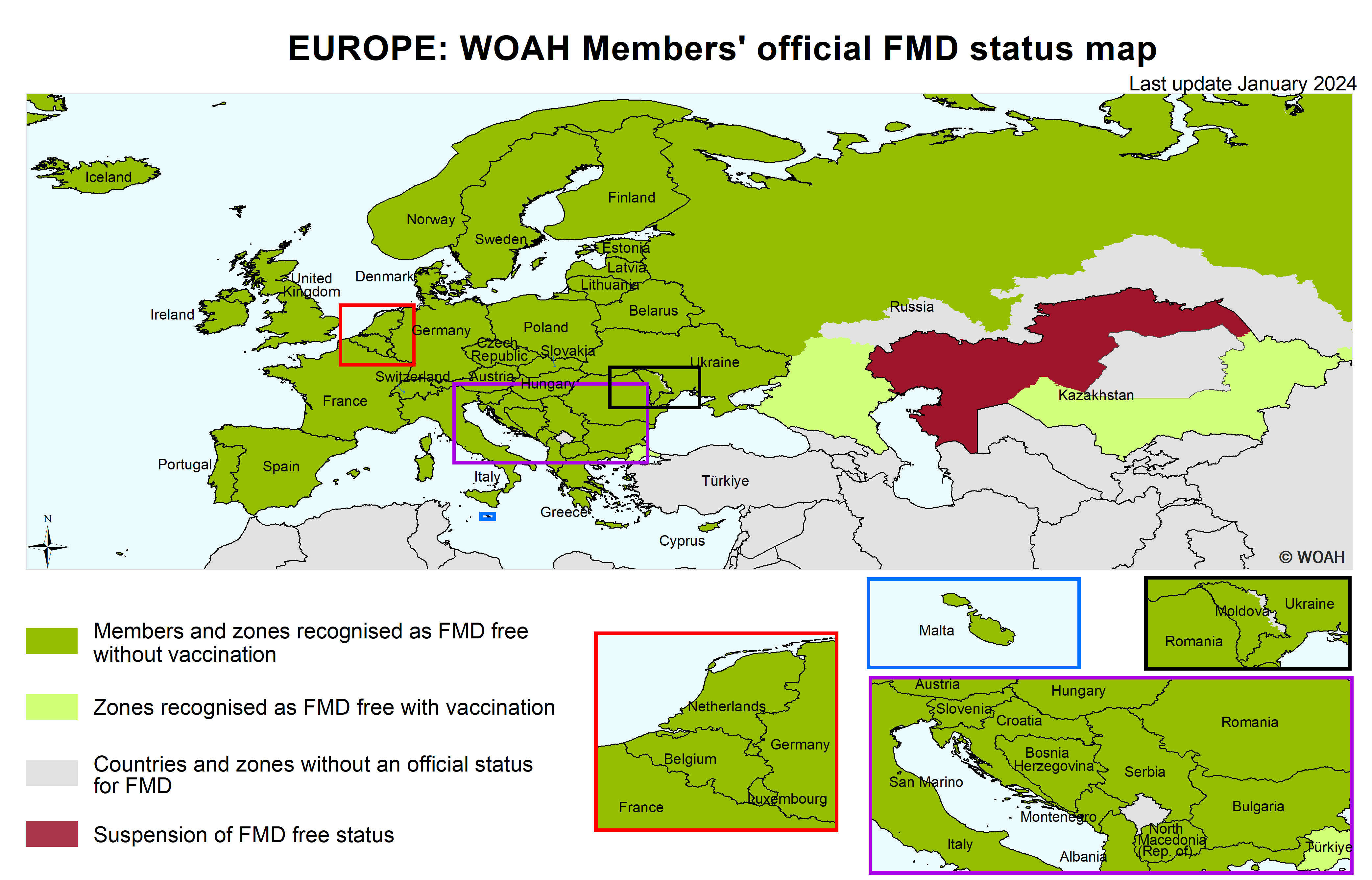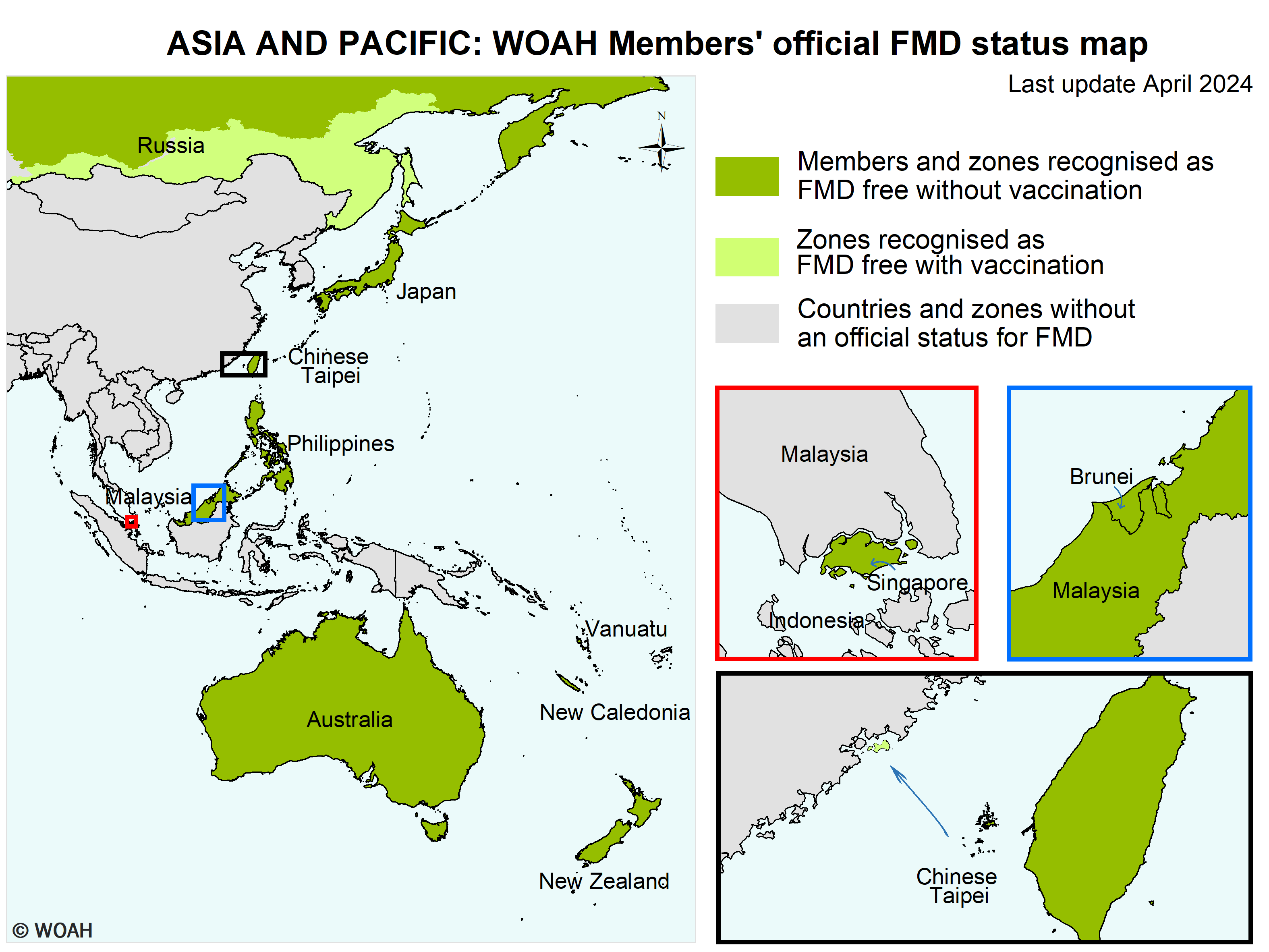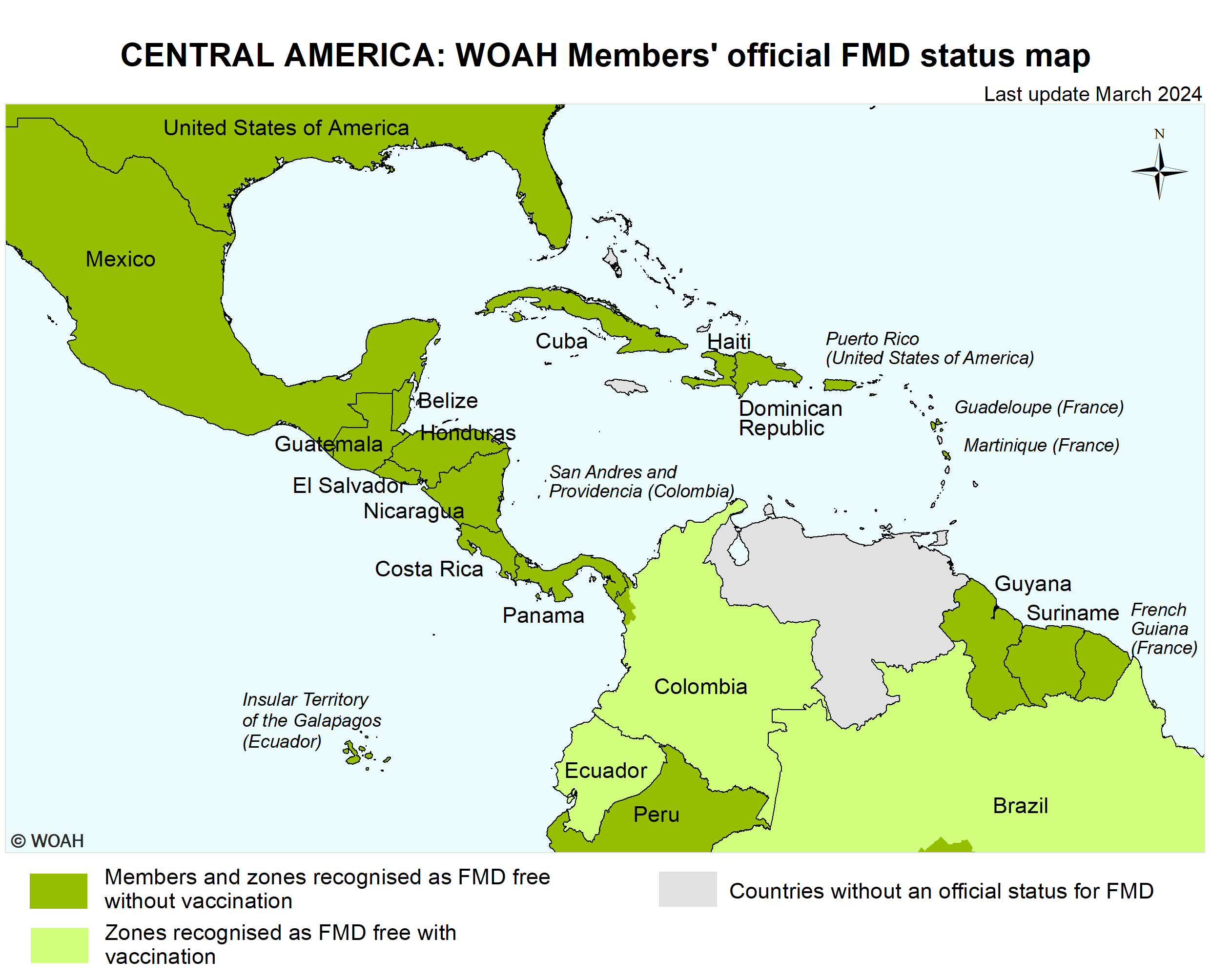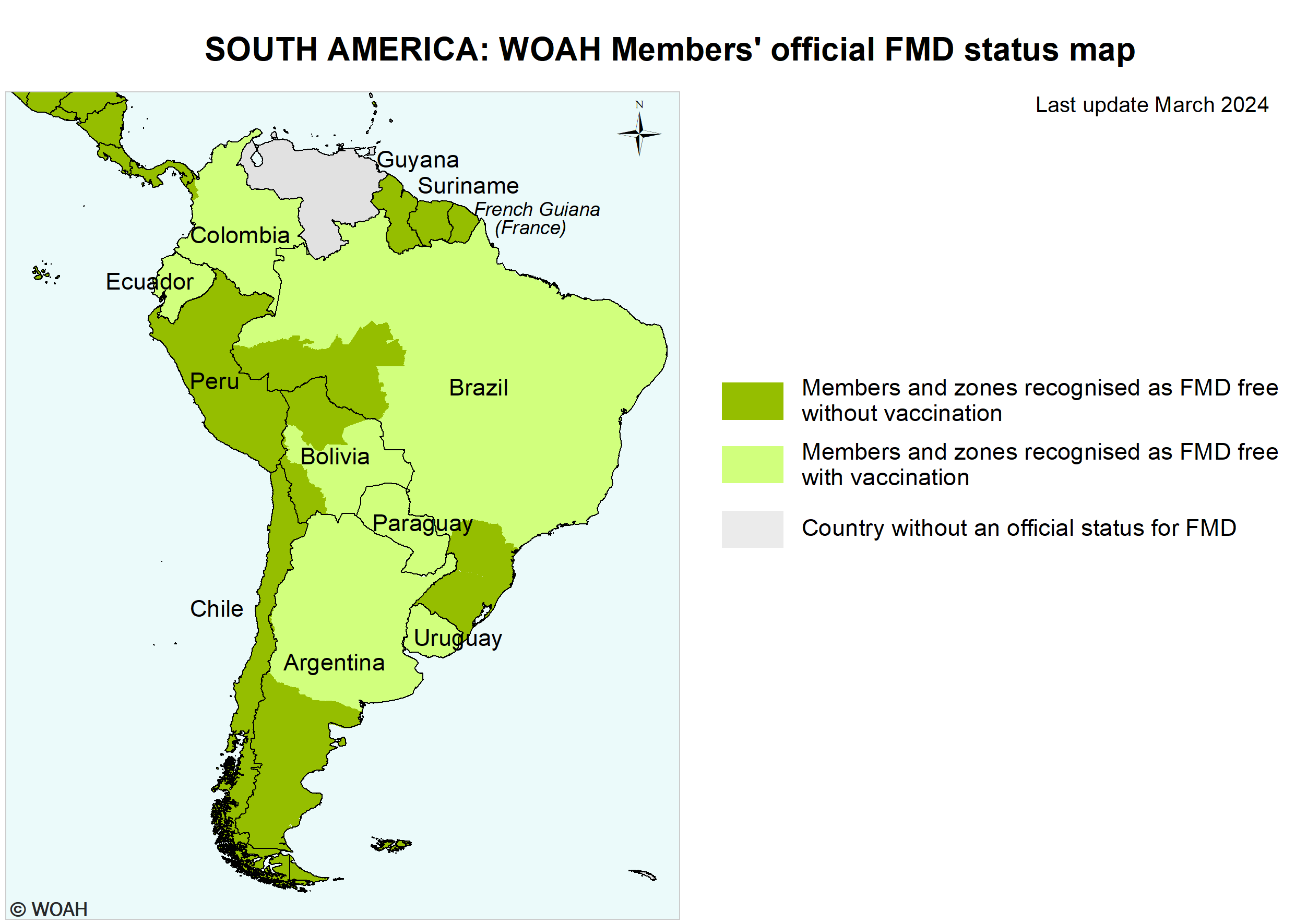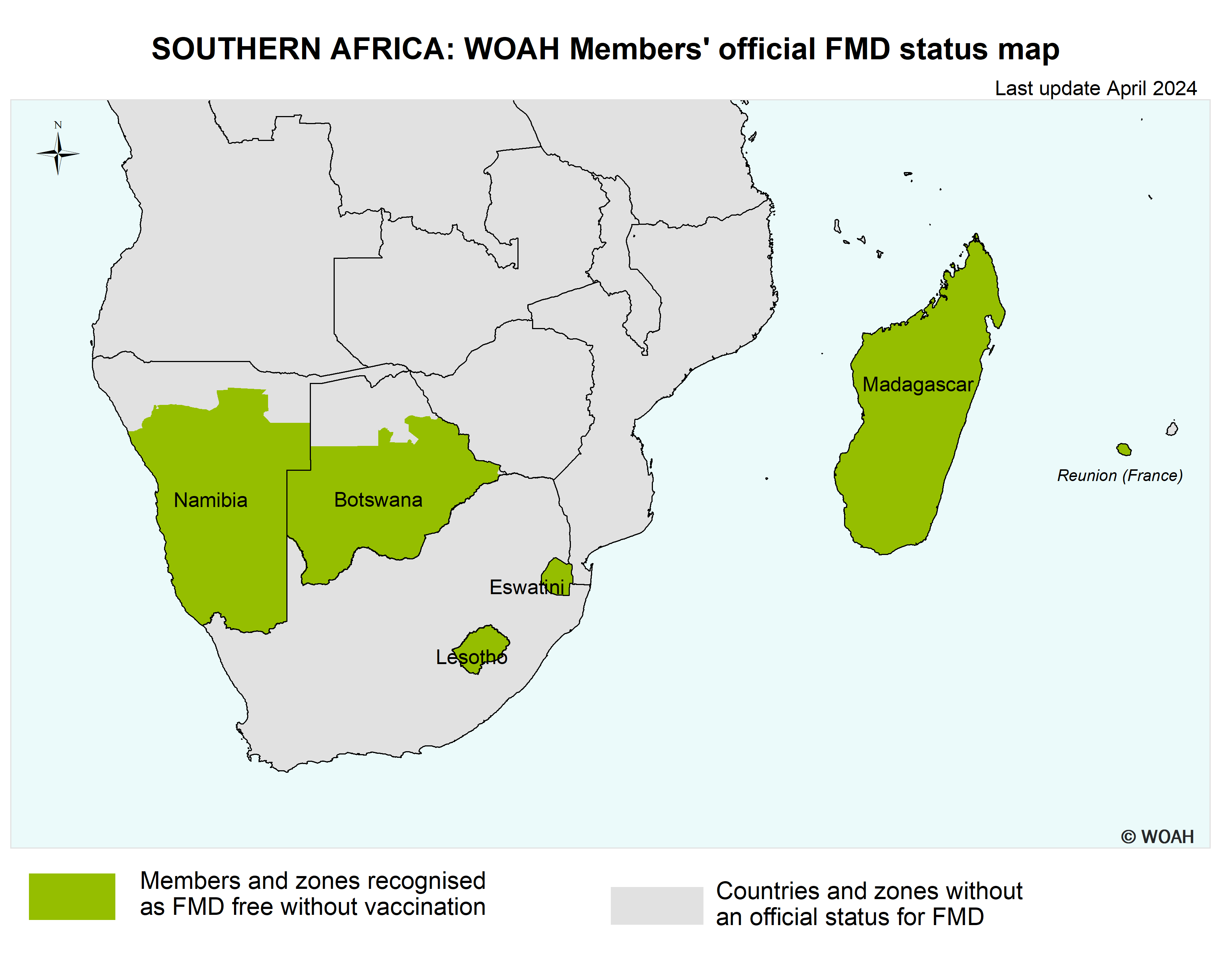Foot and mouth disease
Foot and mouth disease (FMD) is a severe, highly contagious viral disease of livestock that has a significant economic impact. The disease affects cattle, swine, sheep, goats and other cloven-hoofed ruminants. It is a transboundary animal disease (TAD) that deeply affect the production of livestock and disrupting regional and international trade in animals and animal products. The disease is estimated to circulate in 77% of the global livestock population, in Africa, the Middle East and Asia, as well as in a limited area of South America. Countries that are currently free of FMD without vaccination remain under constant threat of an incursion. Seventy-five percent of the costs attributed to FMD prevention and control are incurred by low income and lower-middle income countries. Africa and Eurasia are the regions which incur the largest costs, accounting for 50% and 33% of the total costs respectively. FMD is caused by an Aphthovirus of the family Picornaviridae, seven strains (A, O, C, SAT1, SAT2, SAT3, and Asia1) are endemic in different countries worldwide. Each strain requires a specific vaccine to provide immunity to a vaccinated animal. Its prevention is based on the presence of early detection and warning systems and the implementation of effective surveillance among other measures. FMD is the first disease for which WOAH established an official list of disease-free countries which can be officially recognised as free of the disease either in their entirety or in defined zones and compartments.
Links to Code and Manual
-
Terrestrial code
-
Terrestrial manual
What is Foot and Mouth disease (FMD)?
Foot and mouth disease (FMD) is a severe, highly contagious viral disease of livestock that has a significant economic impact. The disease affects cattle, swine, sheep, goats and other cloven-hoofed ruminants.
Intensively reared animals are more susceptible to the disease than traditional breeds. The disease is rarely fatal in adult animals, but there is often high mortality in young animals due to myocarditis or, when the dam is infected by the disease, lack of milk.
FMD is characterised by fever and blister-like sores on the tongue and lips, in the mouth, on the teats and between the hooves. The disease causes severe production losses, and while the majority of affected animals recover, the disease often leaves them weakened and debilitated.
The organism which causes FMD is an aphthovirus of the family Picornaviridae. There are seven strains (A, O, C, SAT1, SAT2, SAT3, and Asia1) which are endemic in different countries worldwide. Each strain requires a specific vaccine to provide immunity to a vaccinated animal.
All seven of the serotypes have also been found in wildlife, although the latter does not play a significant role in the maintenance of the disease. To date, the only confirmed reservoir in wildlife is African buffalo Syncerus caffer).
FMD is an WOAH-listed disease and must be reported to the Organisation, as indicated in the Terrestrial Animal Health Code.
It was the first disease for which the World Organisation for Animal Health (WOAH, founded as OIE) established official status recognition. Members can also apply for official endorsement of their national control programmes.
Transmission and spread
FMD is found in all excretions and secretions from infected animals. Notably, these animals breathe out a large amount of aerosolised virus, which can infect other animals via the respiratory or oral routes.
The virus may be present in milk and semen for up to 4 days before the animal shows clinical signs of disease.
The significance of FMD is related to the ease with which the virus can spread through any or all of the following:
- infected animals newly introduced into a herd (carrying virus in their saliva, milk, semen, etc.);
- contaminated pens/buildings or contaminated animal transport vehicles;
- contaminated materials such as hay, feed, water, milk or biologics;
- contaminated clothing, footwear, or equipment;
- virus-infected meat or other contaminated animal products (if fed to animals when raw or improperly cooked);
- infected aerosols (spread of virus from an infected property via air currents).
Animals that have recovered from infection may sometimes carry the virus and initiate new outbreaks of the disease.
Public health risk
FMD is not readily transmissible to humans and is not a public health risk.
Clinical signs
The severity of clinical signs will depend on the strain of virus, the exposure dose, the age and species of animal and the host immunity. Morbidity can reach 100% in susceptible populations. Mortality is generally low in adult animals (1–5%), but higher in young calves, lambs and piglets (20% or higher). The incubation period is 2–14 days.
Clinical signs can range from mild or inapparent to severe: they are more severe in cattle and intensively reared pigs than in sheep and goats.
The typical clinical sign is the occurrence of blisters (or vesicles) on the nose, tongue or lips, inside the oral cavity, between the toes, above the hooves, on the teats and at pressure points on the skin. Ruptured blisters can result in extreme lameness and reluctance to move or eat. Usually, blisters heal within 7 days (sometimes longer), but complications, such as secondary bacterial infection of open blisters, can also occur.
Other frequent symptoms are fever, depression, hypersalivation, loss of appetite, weight loss, growth retardation and a drop in milk production, which can persist even after recovery. Chronically affected animals are reported to have an overall reduction of 80% in milk yield. The health of young calves, lambs, and piglets may be compromised by lack of milk if dams are infected.
Death can occur before development of blisters due to a multifocal myocarditis. Myositis may also occur in other sites.
More information on the disease can be found in the WOAH Technical Disease Card.
Diagnostic
The disease may be suspected based on clinical signs. However, FMD cannot be differentiated clinically from other vesicular diseases, such as swine vesicular disease, vesicular stomatitis and vesicular exanthema.
Confirmation of any suspected FMD case through laboratory tests is therefore a matter of urgency. Relevant tests are described in the Terrestrial Manual.
Prevention and control
The initial measures described in the Global Foot and Mouth disease control strategy are the presence of early detection and warning systems and the implementation of effective surveillance in accordance with the guidelines detailed in the Terrestrial Code. They help monitor the occurrence and prevalence of the disease and allow characterisation of FMD viruses.
The implementation of the FMD control strategy varies from country to country and depends on the epidemiological situation of the disease:
In general, it is essential for livestock owners and producers to maintain sound biosecurity practices to prevent the introduction and spread of the virus.
Measures that are recommended at the farm level include:
- control over people’s access to livestock and equipment;
- controlled introduction of new animals into existing herds;
- regular cleaning and disinfection of livestock pens, buildings, vehicles and equipment;
- monitoring and reporting of illness;
- appropriate disposal of manure and dead carcasses.
Contingency planning for potential outbreaks will identify the elements included in a response effort to eradicate the disease, such as:
- humane destruction of all infected, recovered and FMD-susceptible contact animals;
- appropriate disposal of carcasses and all animal products;
- surveillance and tracing of potentially infected or exposed livestock;
- strict quarantine and controls on movement of livestock, equipment, vehicles, and;
- thorough disinfection of premises and all infected materials (implements, cars, clothes, etc.).
Use of vaccination
Depending on the FMD situation, vaccination strategies can be designed to achieve mass coverage or be targeted to specific animal sub-populations or zones. Vaccination programmes carried out in a target population should meet several critical criteria, mainly:
- coverage should be at least 80%;
- campaigns should be completed in the shortest possible time;
- vaccination should be scheduled to allow for interference from maternal immunity;
- vaccines should be administered in the correct dose and by the correct route;
The vaccines used should meet WOAH standards of potency and safety, and the strain or strains in the vaccine must antigenically match those circulating in the field.
It is important to use inactivated virus vaccines, as inactivated virus does not have the ability to multiply in vaccinated animals. The use of live virus vaccines is not acceptable due to the danger of reversion to virulence
Vaccination can play a role in an effective control strategy for FMD, but the decision on whether or not to use vaccination lies with national authorities.
For more information on FMD vaccination, consult the related FAQ.
Geographical distribution
Foot and Mouth Disease is endemic in several parts of Asia and in most of Africa and the Middle East. In Latin America, the majority of countries apply zoning and are recognised as FMD-free, either with or without vaccination.
Australia, New Zealand, Indonesia, Central and North America, and continental Western Europe are currently free of FMD. However, FMD is a transboundary animal disease that can occur sporadically in any typically free area.
Global and regional activities
Global
Africa
- OIE Cost-benefit and feasibility analysis for establishing a foot and mouth disease free zone in Rukwa region in Tanzania (2017) Feasibility study for the establishment of FMD-free fresh meat producing cattle subpopulations in Zimbabwe (2017)
Asia and the Pacific
- Report of the 22 nd Meeting of the OIE SubCommission for Foot and Mouth Disease Control in South-East Asia and China (2016)
- Report of the 21st Meeting of the OIE SubCommission for Foot and Mouth Disease Control in South-East Asia and China (2015)Risk analysis on incursion of exotic FMD viruses into Southeast Asia (2017)Sub-Regional activities on SEACFMD The South-East Asia and China Foot and Mouth Disease (SEACFMD) Campaign
Middle East
- Report of the Seminar on FMD Progressive Control Pathway (2012) GF-TADs consultative meeting on control progress of FMD and PPR (2015)Inter-Regional Consultative Meeting on FMD & PPR Situation Progress (2014) OIE Regional Workshop on the OIE procedure for the official recognition of Member Countries disease status and for the endorsement of national official control programme with regard to foot and mouth disease and peste des petits ruminants (2016)Second PPR and FMD Regional roadmap meeting for the Middle East (2017)
References
In accordance with the WOAH procedure for official recognition of disease status, this page provides access to the List of WOAH Members officially recognised free from foot and mouth disease (FMD) by the WOAH through the adoption of a resolution by the World Assembly of Delegates (Assembly) of the WOAH at the General Session in May every year.
A Member wishing to be officially recognised as disease-free by the WOAH should submit the questionnaire laid out in Chapter 1.6. of the Terrestrial Animal Health Code (Terrestrial Code) and comply with all requirements specified in the Terrestrial Code for FMD. The WOAH Scientific Commission for Animal Diseases (Scientific Commission) is responsible for undertaking, on behalf of the Assembly, the assessment of WOAH Members’ applications for their compliance with WOAH standards. The assessment carried out by the Scientific Commission is based on the recommendations formulated by a relevant ad hoc Group composed of world specialists in disease control.
-
Questionnaire
A_Questionnaire_FMD
.docx – 119 KB See the document -
Questionnaire
A_Questionnaire_FMD__programme
.docx – 71 KB See the document
Subsequent to a disease outbreak or when the Scientific Commission determines that the conditions are not met anymore to demonstrate compliance with the relevant requirements of the Terrestrial Code, a disease status may be suspended. The Scientific Commission may decide to reinstate the suspended status when a Member has submitted an application which fulfils all the requirements requested for the recovery of official disease status laid out in the relevant Chapters of the Terrestrial Code. The suspensions and recoveries of disease status are announced by the Director General of the WOAH in consultation with the Scientific Commission and the list of these is kept up to date until adoption of a new resolution by the Assembly the following May.
Members with a disease free status officially recognised by the WOAH must submit an annual reconfirmation form by the end of November every year.
-
.docx – 67 KB See the document
-
.docx – 43 KB See the document
Map of FMD official status
List of FMD free Members
According to Resolution No. 11 (90th General Session, May 2023)
FMD free where vaccination is not practised
Members recognised as FMD free where vaccination is not practised, according to the provisions of Chapter 8.8. of the Terrestrial Code :
| Albania | Germany | North Macedonia (Rep. of) |
| Australia | Greece | Norway |
| Austria | Guatemala | Panama |
| Belarus | Guyana* | Peru |
| Belgium | Haiti | Philippines |
| Belize | Honduras | Poland |
| Bosnia and Herzegovina | Hungary | Portugal (4) |
| Brunei | Iceland | Romania |
| Bulgaria | Ireland | San Marino |
| Canada | Italy | Serbia (5) |
| Chile | Japan | Singapore |
| Costa Rica | Latvia | Slovakia |
| Croatia | Lesotho | Slovenia |
| Cuba | Lithuania | Spain (6) |
| Cyprus | Luxembourg | Suriname |
| Czech Rep. | Madagascar | Sweden |
| Denmark (1) | Malta | Switzerland |
| Dominican Republic | Mexico | The Netherlands |
| El Salvador | Montenegro | Ukraine |
| Estonia | New Caledonia | United Kingdom (7) |
| Eswatini | New Zealand | United States of America (8) |
| Finland (2) | Nicaragua | Vanuatu |
| France (3) |
(2) Including Åland Islands.
(3) Including French Guiana, Guadeloupe, Martinique, Réunion, Saint Pierre and Miquelon.
(4) Including Azores and Madeira.
(5) Excluding Kosovo administered by the United Nations
(6) Including Balearic Islands and Canary Islands.
(7) Including Guernsey (incl. Alderney and Sark), Isle of Man, Jersey and Falkland Islands (Malvinas). (A dispute exists between the Government of Argentina and the Government of the United Kingdom of Great Britain and Northern Ireland concerning sovereignty over the Falkland Islands (Malvinas) (see resolution 2065 (XX) of the General Assembly of the United Nations)..
(8) Including American Samoa, Guam, Northern Mariana Islands, Puerto Rico and US Virgin Islands.
(*) Please refer to the ‘Suspension/reinstatement of status’ section at the bottom of the FMD-webpage for more details.
FMD free where vaccination is practised
Members recognised as FMD free where vaccination is practised, according to the provisions of Chapter 8.8. of the Terrestrial Code :
Paraguay, Uruguay
FMD free zone where vaccination is not practised
Members having an FMD free zone(9) where vaccination is not practised, according to the provisions of Chapter 8.8. of the Terrestrial Code :
| Argentina Map | + one zone designated by the Delegate of Argentina in a document addressed to the Director General in January 2007; + the summer pasture zone in the Province of San Juan as designated by the Delegate of Argentina in a document addressed to the Director General in April 2011; + Patagonia Norte A as designated by the Delegate of Argentina in a document addressed to the Director General in October 2013; |
| Bolivia Map | + one zone in the Macro-region of the Altiplano designated by the Delegate of Bolivia in documents addressed to the Director General in November 2011; + one zone consisting of the Department of Beni and the northern part of the Department of La Paz merged with the zone consisting of the Department of Pando (August 2018), as designated by the Delegate of Bolivia in a document addressed to the Director General in September 2022; |
| Botswana Map | + four zones designated by the Delegate of Botswana in documents addressed to the Director General in August and November 2014 as follows: – one zone consisting of Zones 3c (Dukwi), 4b, 5, 6a, 8, 9, 10, 11, 12 and 13; – one zone consisting of Zone 3c (Maitengwe); – one zone covering Zone 4a; – one zone covering Zone 6b; + one zone covering Zone 3b designated by the Delegate of Botswana in a document addressed to the Director General in August 2016; + one zone covering Zone 7 designated by the Delegate of Botswana in a document addressed to the Director General in August 2018; |
| Brazil Map | + State of Santa Catarina designated by the Delegate of Brazil in a document addressed to the Director General in February 2007; + three zones of Brazil as designated by the Delegate of Brazil in a document addressed to the Director General in August 2020 as follows: – State of Paraná; – State of Rio Grande do Sul; – one zone (Block 1) including the States of Acre and Rondônia and 14 municipalities in the State of Amazonas and five municipalities in the State of Mato Grosso; |
| Chinese Taipei Map | + one zone covering Taiwan, Penghu and Matsu areas, as designated by the Delegate of Chinese Taipei in a document addressed to the Director General in September 2019; |
| Colombia Map | + one zone designated by the Delegate of Colombia in documents addressed to the Director General in November 1995 and in April 1996 (Area I – Northwest region of Chocó Department); + one zone designated by the Delegate of Colombia in documents addressed to the Director General in January 2008 (Archipelago de San Andrés and Providencia); |
| Ecuador Map | + one zone consisting of the insular territory of the Galápagos, as designated by the Delegate of Ecuador in a document addressed to the Director General in August 2014; |
| Malaysia Map | + one zone covering the provinces of Sabah and Sarawak as designated by the Delegate of Malaysia in a document addressed to the Director General in December 2003; |
| Moldova Map | + one zone designated by the Delegate of Moldova in a document addressed to the Director General in July 2008; |
| Namibia Map | + one zone designated by the Delegate of Namibia in a document addressed to the Director General in February 1997. |
| Russia Map | + one zone designated by the Delegate of Russia in documents addressed to the Director General in August 2015 and March 2016; |
FMD free zone where vaccination is practised
Members having an FMD free zone(10) where vaccination is practised, according to the provisions of Chapter 8.8. of the Terrestrial Code:
| Argentina Map | + two separate zones designated by the Delegate of Argentina in documents addressed to the Director General in March 2007 and October 2013, and in August 2010 and February 2014; |
| Bolivia Map | + one zone covering the regions of Chaco, Valles and parts of Amazonas and Altiplano as designated by the Delegate of Bolivia in documents addressed to the Director General in October 2013, February 2014 and August 2018; |
| Brazil Map | + one zone consisting of two merged zones designated by the Delegate of Brazil in documents addressed to the Director General in August 2010, September 2017 and September 2019, covering the States of Alagoas, Amapá, Amazonas, Bahia, Ceará, Espírito Santo, Goiás, Mato Grosso, Mato Grosso do Sul, Maranhão, Minas Gerais, Pará, Paraíba, Pernambuco, Piauí, Rio de Janeiro, Rio Grande do Norte, Roraima, São Paulo, Sergipe, Tocantins and Distrito Federal, with the exclusion of the municipalities of the States of Amazonas and Mato Grosso that are part of the zone of Block 1 (free from FMD where vaccination is not practised) as addressed to the Director General in August 2020; |
| Chinese Taipei Map | + one zone consisting of Kinmen County as designated by the Delegate of Chinese Taipei in a document addressed to the Director General in September 2017; |
| Colombia Map | + three separated zones designated by the Delegate of Colombia in documents addressed to the Director General in September 2019 as follows: – Zone I (Northern border) consisting of Departments of La Guajira, Cesar and part of the Department of Norte de Santander; – Zone III (Trade) consisting of the Departments of Atlántico, Córdoba, Magdalena, Sucre and part of Antioquia, Bolívar and Chocó Departments; – Zone IV (Rest of the country), consisting of the Departments of Amazonas, Caldas, Caquetá, Cauca, Casanare, Cundinamarca, Guainía, Guaviare, Huila, Meta, Nariño, Quindío, Putumayo, Risaralda, Santander, Tolima, Valle del Cauca, Vaupés and part of Antioquia, Bolívar, Boyacá, and Chocó Departments, + one zone consisting of two merged zones designated by the Delegate of Colombia in documents addressed to the Director General in September 2019 and in August 2020, which includes Zone II (Eastern border) and the former high surveillance zone covering the Departments of Arauca and Vichada and the municipality of Cubará of the Department of Boyacá; + one zone, namely Protection Zone I (PZ I) covering 29 municipalities of the Department of Norte de Santander, as designated by the Delegate of Colombia in a document addressed to the Director General in September 2022; |
| Ecuador Map | + one zone consisting of the continental Ecuador, as designated by the Delegate of Ecuador in a document addressed to the Director General in August 2014; |
| Kazakhstan Map | + five separate zones designated by the Delegate of Kazakhstan in documents addressed to the Director General in August 2016 as follows: – Zone 1 consisting of Almaty region; – Zone 2 consisting of East Kazakhstan region; – Zone 3 including part of Kyzylorda region, northern part of South Kazakhstan region, northern and central parts of Zhambyl region; – Zone 4 including southern part of Kyzylorda region and south-western part of South Kazakhstan region; – Zone 5 including south-eastern part of South Kazakhstan region and southern part of Zhambyl region; |
| Russia Map | + two zones of Russia as designated by the Delegate of Russia in documents addressed to the Director General in August 2020 as follows: – Zone-South including Southern and North Caucasian Federal Districts, consisting of 13 Subjects: Rostov Oblast, Stavropol Krai, Krasnodar Krai, Volgograd Oblast, Astrakhan Oblast, Republic of Kalmykia, Chechen Republic, Republic of Ingushetia, Republic of Dagestan, Kabardino-Balkarian Republic, Karachay-Cherkess Republic, Republic of North Ossetia-Alania, Republic of Adygea; – Zone-Sakhalin consisting of the Island of Sakhalin and the Kurile Islands; + one zone of Eastern Siberia consisting of two Subjects (Republic of Tuva and Republic of Buryatia) and one administrative Raion of the Republic of Altai (Kosh-Agachsky Raion) designated by the Delegate of Russia in a document addressed to the Director General in August 2021; + one zone, namely Zone V ‘Far East’ consisting of five Subjects: Amur Oblast, Jewish Autonomous Oblast, Primorsky Krai, Khabarovsky Krai, Zabaykalsky Krai, as designated by the Delegate of Russia in a document addressed to the Director General in September 2022; |
| Türkiye (Rep. of) Map | + one zone designated by the Delegate of Türkiye (Rep. of) in a document addressed to the Director General in November 2009. |
List of Members with an endorsed official control programme for FMD
According to Resolution No. 12 (90th General Session, May 2023)
Endorsed official control programme for FMD
Members with an endorsed official control programme for FMD, according to the provisions of Chapter 8.8. of the Terrestrial Code:
| Botswana | Kyrgyzstan | Namibia |
| China (People’s Rep. of)* | Morocco | Thailand |
| India |
Suspension/reinstatement of status
Reinstatement of the FMD-free status of a containment zone where vaccination is not practised
Botswana
Following an immediate notification received from the Delegate of Botswana on an outbreak of FMD in Butale crush, Masungu, the “FMD-free zone where vaccination is not practised” status of Zone 6b of Botswana consisting of part of Francistown as recognised by the World Assembly of Delegates in terms of Resolution No. 11 in May 2022 was suspended with effect from 18 August 2022.
A containment zone was established within Zone 6b in Bisoli North, as described in the documentation submitted by the Delegate to WOAH on 28 November 2022 and 10 February 2023, and the “FMD-free zone where vaccination is not practised” status was re-instated in Zone 6b with effect from 03 March 2023, with the exception of the territory of the containment zone.
The Delegate of Botswana submitted an application for the reinstatement of the FMD-free status of the containment zone in accordance with the relevant provisions of the WOAH Terrestrial Animal Health Code (Terrestrial Code). The Scientific Commission, by electronic correspondence, considered the application in accordance with Resolution No. 15 of the 2020 Adapted Procedure and the Standard Operating Procedures on suspension, recovery, or withdrawal of officially recognised animal health status and concluded that the containment zone within Zone 6b fulfils the requirements of the Terrestrial Code to reinstate its FMD-free status with effect from 10 April 2024.
Reinstatement of an “FMD-free country where vaccination is not practised” status
Guyana
Following the failure to submit the annual reconfirmation and the adequate documented evidence by the end of January 2024, the “FMD-free country where vaccination is not practised” status of Guyana, as recognised by the WOAH World Assembly of Delegates in terms of Resolution No. 11 in May 2023, was suspended on 20 February 2024.
The Delegate of Guyana submitted an updated report for the reinstatement of its official status. The Scientific Commission for Animal Diseases considered the information provided by Guyana in accordance with Resolution No. 15 of the 2020 Adapted Procedure and concluded to reinstate the “FMD-free country where vaccination is not practised” status of Guyana with effect from 22 March 2024.
Withdrawal of WOAH endorsement of ‘official control programme for FMD’
China (People’s Rep. of)
Following the assessment of China’s annual reconfirmation for its official control programme for FMD endorsed by WOAH, the Scientific Commission for Animal Diseases concluded that China no longer fulfils the requirements in Articles 1.6.2. and 8.8.39. of the Terrestrial Animal Health Code for a country having an endorsed official control programme for FMD. As a result, the endorsement of the “official control programme for FMD” for China, as recognised by the World Assembly of Delegates in terms of Resolution No. 12 in May 2023, was withdrawn with effect from 20 February 2024.
Suspension of an “FMD free zone where vaccination is not practised” status
Kazakhstan
Following a letter received from the Delegate of Kazakhstan informing WOAH about the start of vaccination against FMD, the “FMD free zone where vaccination is not practised” status of Zone 1 (consisting of West Kazakhstan, Atyrau, Mangystau and south-western part of Aktobe region), Zone 2 (including north-eastern part of Aktobe region, southern part of Kostanay region and western part of Karaganda region), Zone 3 (including northern and central parts of Kostanay region, western parts of North Kazakhstan and Akmola regions) and Zone 4 (including central and eastern parts of North Kazakhstan region and northern parts of Akmola and Pavlodar regions) as recognised by the World Assembly of Delegates in terms of Resolution No. 11 in May 2022, is suspended with effect from 9 June 2022.
The resources below provided are developed by WOAH and our partners and are freely accessible and available to everyone
for downloading and distribution.
Do you work with cloven-hoofed animals?
Are you a veterinarian or a veterinary paraprofessional?
You work with cloven-hoofed animals
Learn more about FMD and how to curb it
-
.pdf – 3 MB See the document
-
.pdf – 652 KB See the document
-
.pdf – 1 MB See the document
-
.pdf – 1,015 KB See the document
-
Guidance
Biosecurity Guidelines for Traders
.pdf – 1 MB See the document
You are a veterinarian or a veterinary paraprofessional
Learn more on sampling for FMD diagnosis
-
.pdf – 938 KB See the document


